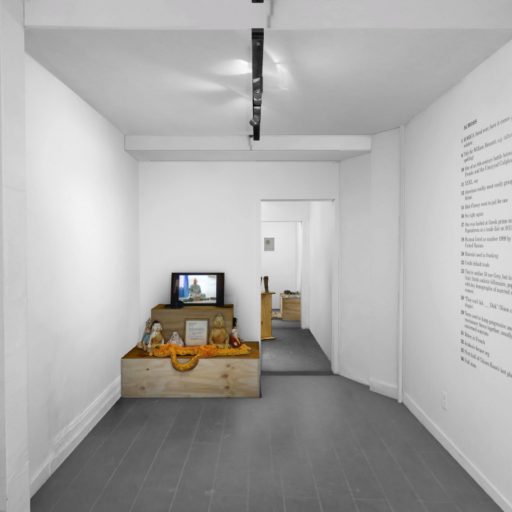

David Lewis is pleased to announce a survey of major works by Thornton Dial.
In 1993, Dial made his New York museum solo debut with Thornton Dial: Image of the Tiger, at the New Museum (in association with the American Folk Art Museum). Of these works, Amiri Baraka said: “The paintings featured in Thornton Dial: Image of the Tiger will have to be acknowledged, one day soon, as one of the most important arti... more >>
David Lewis is pleased to announce a survey of major works by Thornton Dial.
In 1993, Dial made his New York museum solo debut with Thornton Dial: Image of the Tiger, at the New Museum (in association with the American Folk Art Museum). Of these works, Amiri Baraka said: “The paintings featured in Thornton Dial: Image of the Tiger will have to be acknowledged, one day soon, as one of the most important artistic gestalts by a North American painter of the period, and remember that these are a single fragment of Dial’s oeuvre.”1 Roberta Smith, writing in The New York Times, said: “Thornton Dial’s work is just one more sign of things to come, and of things already here.”2 Since then, Dial’s work has only grown in thematic scope and material virtuosity. Nevertheless, despite nearly three decades of celebration, despite numerous museum surveys, including the upcoming survey History Refused to Die at The Metropolitan Museum of Art, Dial’s achievement is still somewhat marginalized, and misunderstood.
The works of Dial’s two-decade-plus maturity demand to be considered as deeply self-reflective masterpieces, each addressing the most salient challenges of American art and history. Dial is a history painter, unflinching in his treatment of the darkest American tragedies and deepest wounds. “Like Anselm Kiefer,” wrote Thomas McEvilly, “Dial has chosen to engage history in its repressed stretches, looking into the darkness where art does not usually go.”3 Much like his fellow Southerners, Robert Rauschenberg and Jasper Johns, Dial claims—and at the same time attacks—the most celebrated images and motifs in American history, in simultaneous awareness and defiance of inherited art and techniques. And, like his celebrated peers, Dial inherits, renews, and expands the tradition of modernist painting, experimenting with unorthodox materials, and reworking the surface of each painting into a powerful sculpted relief surface.
The works in Mr. Dial’s America have been selected to show the range of Dial’s formal ingenuity and inventiveness, and to highlight key subjects and motifs. Subjects range from his classic early “Tiger” image (an allegorical selfportrait, and an emblem of African American struggle) to the O.J. Simpson trial, from the history of lynching and Jim Crow to a blazing field of memorial fire inspired by Dial’s visit to the still-smoldering site of Ground Zero in 2001. Also included is one of Dial’s major meditations on art historical privilege, exclusion, and prerogative (by way of Joseph Beuys) as well a lyrical late assemblage that suggests redemption, an image of rebirth poetically figured as flowers growing from a charred earth.
Thornton Dial (b. Emelle, AL, 1928; d. McCalla, AL, 2016) has had solo exhibitions at the High Museum of Art, Atlanta (2016, 2013); New Orleans Museum of Art (2012); Indianapolis Museum of Art (2011); Museum of Fine Arts, Houston (2005); New Museum of Contemporary Art, New York (1993); and the American Folk Art Museum, New York (1993), among others. Recent group exhibitions include the de Young Museum, San Francisco (2017); Birmingham Museum of Art (2017); Saint Louis Art Museum (2016); Intuit, Chicago (2016); Brooklyn Museum (2015); The Studio Museum in Harlem, New York (2014); Charles H. Wright Museum of African American History, Detroit (2002); Bass Museum of Art, Miami (2002); Whitney Biennial, Whitney Museum of American Art, New York (2000); and the Corcoran Gallery of Art, Washington D.C. (1994), among many others. Dial’s work is included in many public collections including the Metropolitan Museum of Art, New York; Philadelphia Museum of Art, Philadelphia; Museum of Fine Arts, Houston; Hirshhorn Museum and Sculpture Garden, Washington D.C.; Museum of Modern Art, New York; Whitney Museum of American Art, New York; de Young Museum of Art, San Francisco; High Museum of Art, Atlanta; Brooklyn Museum; Harvard Art Museums, Cambridge; and the Smithsonian American Art Museum, Washington D.C., among many others. His work will be included in the forthcoming History Refused to Die: Highlights from the Souls Grown Deep Foundation Gift at The Metropolitan Museum of Art, New York.
Special thanks to the Souls Grown Deep Foundation for their generous support and collaboration.
- Baraka, Amiri. “Revolutionary Traditional Art From the Cultural Commonwealth of Afro-Alabama.” Thornton Dial in the 21st Century. Atlanta, GA: Tinwood Books, 2005, p. 172. Print.
- Smith, Roberta. “A Young Style for an Old Story.” The New York Times, December 19, 1993.
- McEvilley, Thomas. “Proud-Stepping Tiger: History as Struggle in The Work of Thornton Dial.” Thornton Dial: Image of the Tiger. New York, NY: Harry N. Abrams, Inc., 1993, p. 28. Print.










